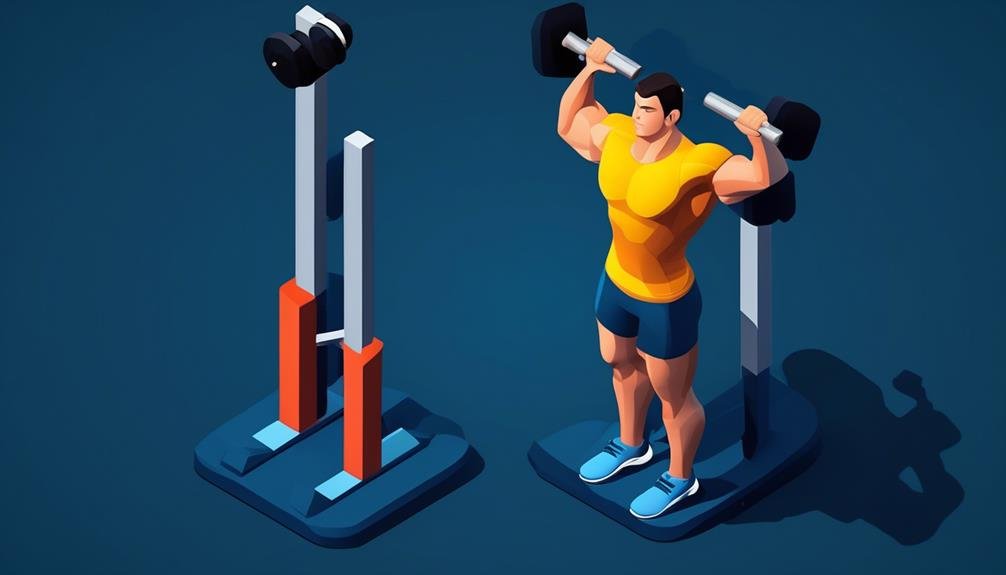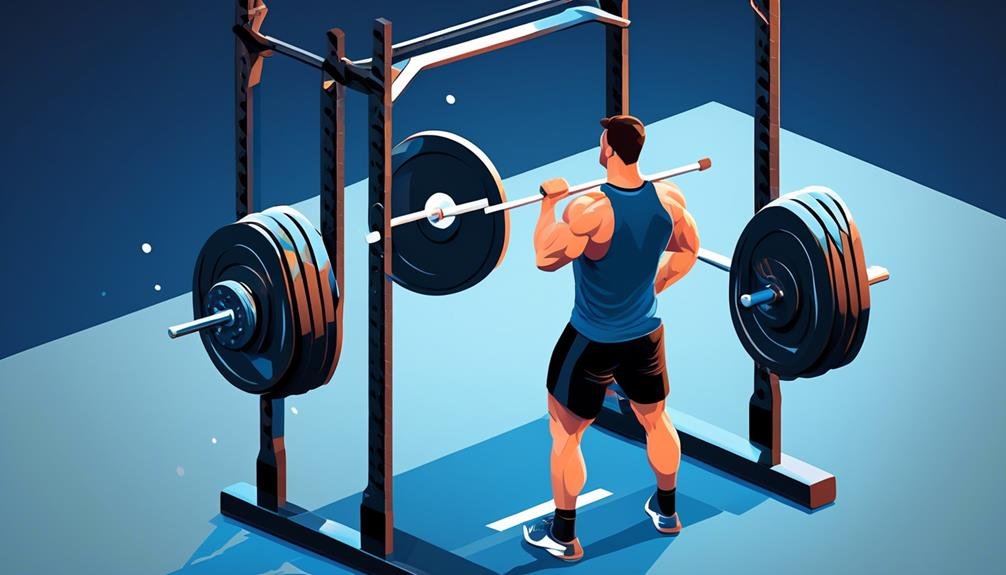Have you ever wondered if it's actually possible to safely lift weights over your head without a spotter? The truth is, while having a spotter is the ideal scenario for heavy overhead lifts, there are ways to minimize the risks and ensure your safety when training alone.
In this discussion, we will explore some practical strategies and techniques that will empower you to lift weights over your head without compromising your well-being.
So, if you're eager to discover how to confidently tackle those overhead exercises solo, keep on reading.
Key Takeaways
- Utilize proper technique and safety measures, such as maintaining perfect form, aligning the body, and gradually increasing weight.
- Consider using dumbbells instead of barbells for independent arm movement, better balance, and the ability to easily drop the weights if necessary.
- Train with lighter weights and higher reps to promote muscular endurance, reduce strain on joints, and focus on proper form.
- Pay attention to foot placement and utilize leg strength to maintain stability and support the weight during overhead lifts.
The Importance of Proper Technique
Proper technique is paramount when lifting weights overhead without a spotter, ensuring your safety and minimizing the risk of injuries. When lifting heavy weights on your own, it's crucial to maintain perfect form throughout the exercise. This involves keeping your body aligned and engaging your core muscles to stabilize your body during the movement. By doing so, you provide essential support to prevent any strain or injury.
To lift weights overhead safely without a spotter, it's important to focus on your range of motion. Start with a weight that you can comfortably handle and gradually increase it as your strength improves. This gradual progression, while maintaining proper form, reduces the risk of injury significantly.
Self-assessment is vital when lifting weights overhead without a spotter. Utilize mirrors or record your lifts to analyze your technique. This way, you can identify any areas that need improvement and work on perfecting your form.
Using Equipment With Built-In Safety Measures
Consider incorporating equipment with built-in safety measures to ensure a secure and effective lifting experience without the need for a spotter. By utilizing these specialized pieces of equipment, you can lift heavy weights overhead with peace of mind. Here are some options to consider:
| Equipment | Safety Measures | Benefits |
|---|---|---|
| Bella Squat | Escape mechanisms for bench press | Allows for safe training without a spotter |
| Modified Hatfield Squat | Escape mechanisms for bench press | Provides safety during heavy lifting |
| Pin Press for Bench Press | Escape mechanisms for bench press | Ensures a secure lifting experience |
| Good-Morning Machine | Adjustable spotter arm | Offers safety and easy escape during deadlifts |
| Dumbbell Exercises | Safer options, ability to drop weights | Reduces the need for a spotter |
| Squat Rack with Safeties | Built-in safeties | Provides added protection during bench press and squat exercises |
| Arnold Schwarzenegger Encyclopedia of Bodybuilding | Resource for safer alternatives and built-in safety mechanisms | Helps prioritize safety in exercise selection |
These equipment options offer various safety measures to protect you while lifting weights overhead. Whether it's the escape mechanisms of the Bella Squat and Modified Hatfield Squat, the adjustable spotter arm of the Good-Morning Machine, or the built-in safeties of the Squat Rack, you can focus on your lifts without worrying about potential accidents. Additionally, opting for dumbbell exercises allows for safer alternatives and the ability to drop weights if needed. Remember to prioritize safety over personal preference when choosing exercises, and consult resources like the Arnold Schwarzenegger Encyclopedia of Bodybuilding for guidance on using equipment with built-in safety mechanisms.
Opting for Dumbbells Over Barbell

To enhance safety and control during overhead lifts, opting for dumbbells instead of a barbell is a wise choice. Dumbbells offer several advantages when it comes to lifting weights safely without a spotter.
One of the key benefits is that using dumbbells allows for independent movement. Unlike a barbell, where both sides are connected, dumbbells enable each arm to work independently. This reduces the risk of one side dominating the lift, which can lead to muscle imbalances or injury.
In addition to independent movement, using dumbbells engages stabilizing muscles, promoting better balance and coordination. When you lift weights overhead with dumbbells, your body has to work harder to stabilize the weight on both sides. This helps to strengthen the smaller, supporting muscles that are often neglected when using a barbell.
Dumbbells also provide more freedom of movement compared to a barbell. With a barbell, the movement is fixed and can be restrictive for some individuals. Dumbbells allow for a natural range of motion, which reduces the risk of strain or injury.
Furthermore, if you find yourself in a situation where you can't complete a lift safely, dumbbells offer the advantage of easy dropping. Unlike a barbell, which may require the assistance of a spotter to rack or unload, you can simply drop the dumbbells to the sides if needed. This ensures your safety in case of a failed lift without the need for a spotter.
Training With Lighter Weights and Higher Reps
When progressing from opting for dumbbells over a barbell for safer overhead lifts, one effective approach is to focus on training with lighter weights and higher reps. This training style offers several benefits that can help you lift weights over your head without a spotter in a much safer manner. Here's what you need to know:
- Muscular Endurance and Cardiovascular Health:
Training with lighter weights and higher reps promotes muscular endurance and cardiovascular health. By performing more repetitions with lighter weights, you can improve your stamina and strengthen your heart.
- Toning and Defining Muscles:
This training method is particularly effective for toning and defining muscles without putting excessive strain on your joints. It allows you to target specific muscle groups and achieve a more sculpted appearance.
- Reduced Risk of Injuries:
Using lighter weights and higher reps can significantly reduce the risk of muscle strains and joint injuries. With proper form and technique, you can focus on lifting without compromising your safety.
Choosing the Right Exercises for Solo Lifting

To ensure your safety during solo lifting sessions, it's crucial to choose the right exercises prioritizing safety over personal preference. When selecting exercises for your home gym, consider using resources like the Arnold Schwarzenegger Encyclopedia of Bodybuilding for safer alternatives. It's important to prioritize safety and injury prevention over muscle effectiveness.
Instead of barbells, opt for dumbbells for added safety during solo training. Dumbbells are versatile and can be used for various exercises. For example, bench pressing and overhead pressing with dumbbells reduce the risk of injury compared to using a barbell. Incorporating dumbbells into your routine can minimize the need for a spotter.
If you have the space and resources, consider adding a power cage or squat rack to your home gym. These safety equipment options provide safeguards to prevent injury during exercises like bench press and squat. The safeties in the rack act as safety pins, ensuring that you can lift without worrying about getting trapped under heavy weights.
Always Prioritizing Form and Posture
Always prioritize proper form and posture when lifting weights overhead to ensure safety and maximize muscle engagement. Here are three key tips to help you maintain the correct form and posture while lifting weights over your head without a spotter:
- Establish a Stable Base: To protect your back and shoulders, maintain a neutral spine, engage your core, and keep your shoulders down and back. This will create a solid foundation and reduce the risk of strain or injury.
- Perfect Your Grip: Pay attention to your grip on the bar. Make sure your wrists are stacked directly over your elbows to minimize strain on your wrists and prevent potential injury.
- Engage Your Lower Body: Don't forget about your lower body! Keep your feet firmly planted on the ground to maintain a stable base. Utilize your legs to generate power and support the overhead lift. This won't only enhance your overall strength but also improve your stability.
Frequently Asked Questions
How Can I Lift Weights Without a Spotter?
You can safely lift weights without a spotter by following proper technique, using appropriate weight, and using safety equipment like a power rack or safety pins. Always prioritize safety and listen to your body.
Do You Need a Spotter for Overhead Press?
You don't necessarily need a spotter for overhead presses, but it's recommended for safety. Utilize proper form, start with manageable weight, and consider using a power cage or squat rack with safeties for added protection.
When Lifting Weights It Is OK to Lift Without Using a Spotter?
When lifting weights, it's generally not recommended to lift without a spotter, especially for exercises with a high risk of injury. Consider using alternatives like machines or dumbbells that offer built-in safety mechanisms.
What Exercises Do Not Require a Spotter?
Some exercises, like dumbbell bench press and overhead barbell presses, can be done safely without a spotter. You can also use safety equipment like squat racks with safeties or choose alternative exercises that don't require a spotter.
Conclusion
In conclusion, when lifting weights over your head without a spotter, it's crucial to prioritize safety. Utilizing equipment with built-in safety measures, such as machines or dumbbells, can help minimize risks.
Opting for lighter weights and higher reps can also reduce the chances of injury. Additionally, always focus on maintaining proper form and posture throughout your lifts.
By following these guidelines, you can safely lift weights over your head without a spotter.
